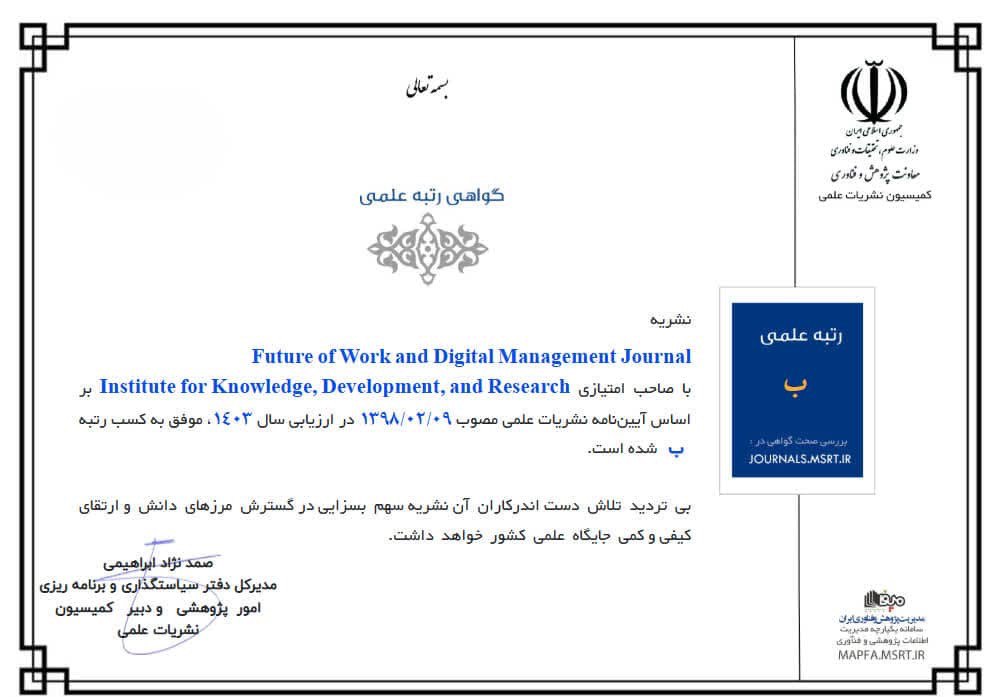Exploring the Human Factors Behind Resistance to Automation in the Workplace
Keywords:
Resistance to automation, human factors, workplace transformation, employee trust, qualitative study, organizational culture, emotional responsesAbstract
This study aimed to identify and analyze the key human factors contributing to resistance to automation in the workplace among employees from diverse sectors in Armenia. A qualitative exploratory research design was adopted, utilizing semi-structured interviews with 26 participants selected through purposive sampling. Participants were drawn from manufacturing, finance, healthcare, logistics, and IT sectors, all of whom had experienced automation-related changes in their job environments. Data collection continued until theoretical saturation was reached. Interviews were transcribed verbatim and analyzed using thematic analysis, following an inductive coding approach with the assistance of NVivo software (version 12). Themes were developed through open, axial, and selective coding, and analytical rigor was ensured through constant comparison and peer review. The analysis yielded four main themes influencing resistance to automation: perceived job insecurity, emotional and psychological barriers, organizational and cultural factors, and loss of human interaction. Subthemes included fear of unemployment, skill irrelevance, identity threat, exclusion from decision-making, lack of trust in automation, and workplace dehumanization. Participants reported anxiety, reduced motivation, and a diminished sense of role security. Resistance emerged as a rational and emotionally charged response to disruptions in professional identity, communication breakdowns, and perceived inequities. Trust in automation was found to be conditional, context-dependent, and shaped by past experiences and organizational transparency. Resistance to automation is driven by complex emotional, psychological, and structural dynamics rather than mere reluctance to adopt new technologies. Organizations must adopt inclusive, transparent, and empathetic strategies to manage automation transitions, ensuring that employees feel valued, informed, and supported throughout the process. Addressing these human concerns is essential to achieving successful and sustainable automation outcomes.
Downloads
References
[1] T. W. A. Putra and A. Baharum, "Systematic Literature Review : Analysis of the Impact of Supply Chain Automation on Worker Welfare in the Sustainable Industrial Sector," SLRJ, vol. 1, no. 1, pp. 01-11, 2025, doi: 10.70062/slrj.v1i1.51.
[2] T. Harikrishnan, "Psychological Effects of Workplace Automation and AI on Employee Performance," International Journal for Multidisciplinary Research, vol. 7, no. 2, 2025, doi: 10.36948/ijfmr.2025.v07i02.40048.
[3] O. Siebinga, A. Zgonnikov, and D. A. Abbink, "A Model of Dyadic Merging Interactions Explains Human Drivers’ Behavior From Control Inputs to Decisions," Pnas Nexus, vol. 3, no. 10, 2024, doi: 10.1093/pnasnexus/pgae420.
[4] L. Shchekhovska, "Interaction Between Automation and Humans in Supply Chain Planning," Electronic Scientific Journal Intellectualization of Logistics and Supply Chain Management #1 2020, no. 24, pp. 35-42, 2024, doi: 10.46783/smart-scm/2024-24-3.
[5] G. Markkula and M. R. Doğar, "Models of Human Behavior for Human-Robot Interaction and Automated Driving: How Accurate Do the Models of Human Behavior Need to Be?," Ieee Robotics & Automation Magazine, pp. 2-7, 2024, doi: 10.1109/mra.2022.3182892.
[6] M. W. Long, S. Schafrik, P. Kolapo, Z. Agioutantis, and J. Sottile, "Equipment and Operations Automation in Mining: A Review," Machines, vol. 12, no. 10, p. 713, 2024, doi: 10.3390/machines12100713.
[7] N. Farhat, D. v. d. Linden, A. Zamansky, and T. Assif, "Automation in Canine Science: Enhancing Human Capabilities and Overcoming Adoption Barriers," Frontiers in Veterinary Science, vol. 11, 2024, doi: 10.3389/fvets.2024.1394620.
[8] Y. Zhang and A. Talebpour, "Characterizing Human–Automated Vehicle Interactions: An Investigation Into Car-Following Behavior," Transportation Research Record Journal of the Transportation Research Board, vol. 2678, no. 5, pp. 812-826, 2023, doi: 10.1177/03611981231192999.
[9] R. Wei, A. D. McDonald, A. García, and R. K. Mehta, "Is Trust a Belief, Observation, or State: Results From an Active Inference Analysis of Driver-Automation Transitions of Control," Proceedings of the Human Factors and Ergonomics Society Annual Meeting, vol. 67, no. 1, pp. 1152-1153, 2023, doi: 10.1177/21695067231192220.
[10] T. Sato, J. Inman, M. S. Politowicz, E. T. Chancey, and Y. Yamani, "A Meta-Analytic Approach to Investigating the Relationship Between Human-Automation Trust and Attention Allocation," Proceedings of the Human Factors and Ergonomics Society Annual Meeting, vol. 67, no. 1, pp. 959-964, 2023, doi: 10.1177/21695067231194333.
[11] T. Rieger, L. Kugler, D. Manzey, and E. Roesler, "The (Im)perfect Automation Schema: Who Is Trusted More, Automated or Human Decision Support?," Human Factors the Journal of the Human Factors and Ergonomics Society, vol. 66, no. 8, pp. 1995-2007, 2023, doi: 10.1177/00187208231197347.
[12] N. Y. Mbelekani and K. Bengler, "Balancing Automation: Evaluating the Impacts of Landborne and Airborne Automation in Industry," pp. 1-7, 2023, doi: 10.1109/icecet58911.2023.10389474.
[13] H. Ş. İppoliti, N. Trilck, M. Koelle, and S. Boll, "Please, Go Ahead! Fostering Prosocial Driving With Sympathy-Eliciting Automated Vehicle External Displays," Proceedings of the Acm on Human-Computer Interaction, vol. 7, no. MHCI, pp. 1-18, 2023, doi: 10.1145/3604265.
[14] S. H. Haus, P. Gershon, B. Mehler, and B. Reimer, "The Relationship Between Partial-Automation Use and Driver Sentiment Toward Automation," Proceedings of the Human Factors and Ergonomics Society Annual Meeting, vol. 67, no. 1, pp. 1983-1988, 2023, doi: 10.1177/21695067231192246.
[15] H. Detjen, M. Salini, J. Kronenberger, S. Geisler, and S. Schneegaß, "Towards Transparent Behavior of Automated Vehicles," pp. 1-12, 2021, doi: 10.1145/3447526.3472041.
[16] I. Baird, M. Fendley, and R. Warren, "The Human‐Automation Behavioral Interaction Task (HABIT) Analysis Framework," Human Factors and Ergonomics in Manufacturing & Service Industries, vol. 32, no. 6, pp. 452-461, 2022, doi: 10.1002/hfm.20963.
[17] J. H. Hutchinson, L. Strickland, S. Farrell, and S. Loft, "The Perception of Automation Reliability and Acceptance of Automated Advice," 2021, doi: 10.31219/osf.io/9qgdb.
[18] A. Fuetsch, "The Road Toward Behavior-Driven Automation," Ieee Wireless Communications, vol. 28, no. 4, pp. 6-7, 2021, doi: 10.1109/mwc.2021.9535458.
[19] M. Monika and M. Bhatia, "Extraction of Posture Silhouettes Using Human Posture Feature Points and Spatial Masks for Activity Recognition in Public Place," Journal of Engineering Research, 2021, doi: 10.36909/jer.10803.
[20] R. Vragov, "The Human Behavioral Response to Automated Trading," pp. 206-237, 2017, doi: 10.4018/978-1-5225-1680-4.ch009.
[21] A. Zgonnikov, D. A. Abbink, and G. Markkula, "Should I Stay or Should I Go? Cognitive Modeling of Left-Turn Gap Acceptance Decisions in Human Drivers," Human Factors the Journal of the Human Factors and Ergonomics Society, vol. 66, no. 5, pp. 1399-1413, 2022, doi: 10.1177/00187208221144561.
[22] D. Lehoczky, D. Garcia, and P. N. Gade, "Adapting the 3s-Model for Investigating Trust in Arc Solutions in the Danish Construction Industry," Journal of Information Technology in Construction, vol. 27, pp. 991-1009, 2022, doi: 10.36680/j.itcon.2022.048.
[23] Y. Yamani, S. K. Long, and M. Itoh, "Human–Automation Trust to Technologies for Naïve Users Amidst and Following the COVID-19 Pandemic," Human Factors the Journal of the Human Factors and Ergonomics Society, vol. 62, no. 7, pp. 1087-1094, 2020, doi: 10.1177/0018720820948981.
Downloads
Published
Submitted
Revised
Accepted
Issue
Section
License

This work is licensed under a Creative Commons Attribution-NonCommercial 4.0 International License.








